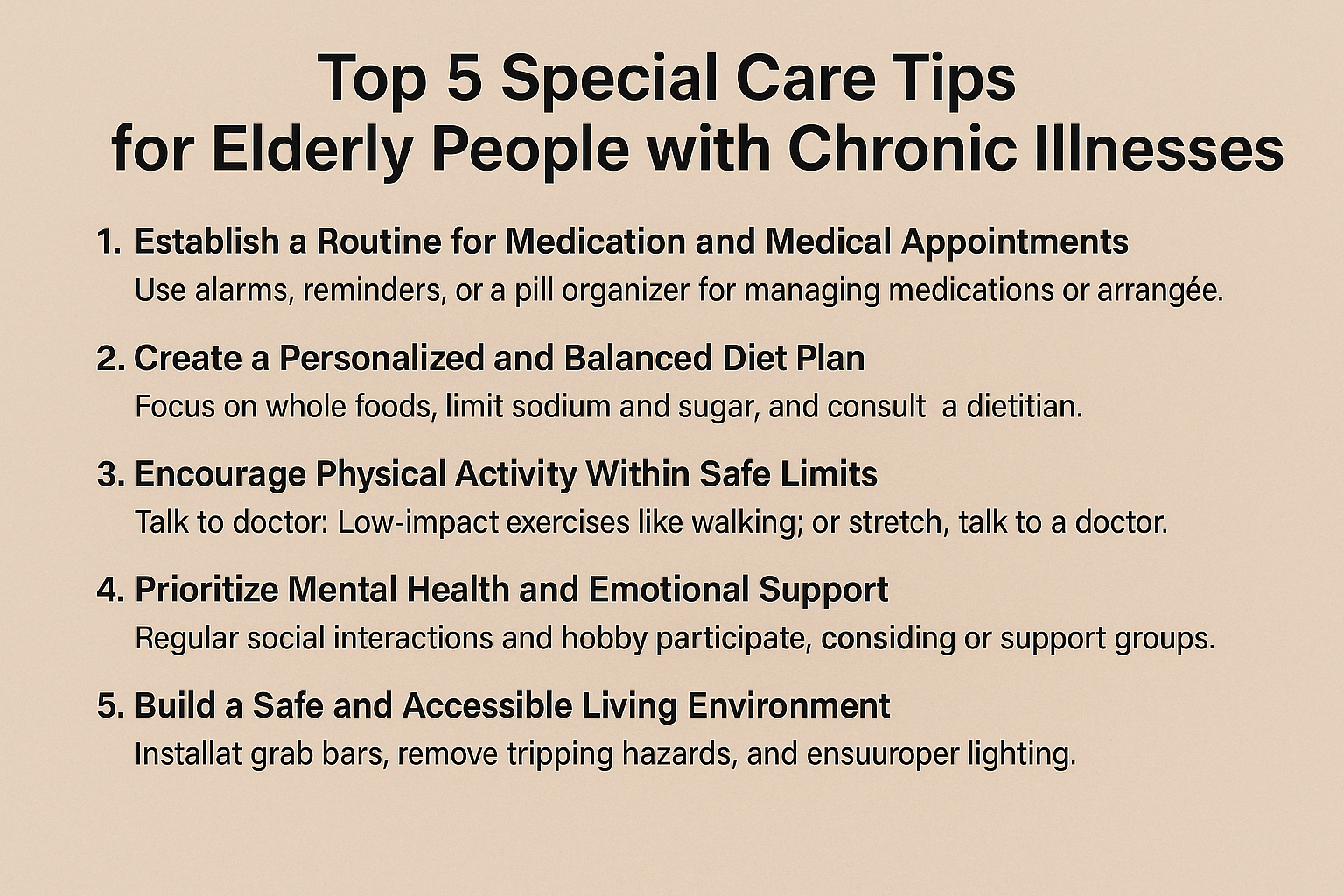As people age, the risk of developing chronic illnesses significantly increases. Conditions like diabetes, heart disease, arthritis, and chronic obstructive pulmonary disease (COPD) can drastically impact an elderly person’s quality of life. Managing these conditions requires consistent, thoughtful care that addresses both the physical and emotional needs of the individual. In this article, we’ll explore the top 5 special care tips that can make a meaningful difference in the lives of elderly people dealing with chronic illnesses.
Chronic illnesses often bring a range of challenges that go beyond medical symptoms. Fatigue, limited mobility, dietary restrictions, and emotional stress can all contribute to a sense of frustration or isolation for seniors. Family members and caregivers play a vital role in helping them maintain a sense of normalcy, dignity, and control over their daily lives. With the right strategies in place, it’s possible to reduce complications and improve overall well-being, even in the presence of long-term health conditions.
Moreover, effective care for chronic illnesses in older adults isn’t just about treatment—it’s about prevention, education, and empowerment. By creating a supportive environment that promotes healthy habits, regular monitoring, and strong communication between all parties involved, caregivers can help seniors stay as active and independent as possible. The following tips are designed to provide practical guidance for anyone looking to enhance the care they provide to an aging loved one facing chronic health issues.
1. Establish a Routine for Medication and Medical Appointments
One of the biggest challenges for elderly individuals with chronic illnesses is adhering to complex medication regimens. Missed doses or incorrect usage can worsen conditions and lead to hospitalizations. Here’s how to support proper medication management:
- Use a pill organizer to separate medications by day and time.
- Set alarms or reminders for each medication schedule.
- Keep a medication log to track usage and note side effects.
- Coordinate with healthcare providers to avoid drug interactions and ensure prescriptions are up to date.
Likewise, regular doctor visits, lab tests, and therapy sessions are critical. Mark these on a visible calendar and help the elderly person prepare questions or concerns to bring to their healthcare provider.
Establishing a routine not only improves adherence but also provides a sense of structure and security for the elderly. When medication and appointments become part of a predictable daily or weekly rhythm, it reduces confusion and anxiety—especially for those with memory challenges. Consistency also allows caregivers to notice patterns or changes in behavior, side effects, or symptoms more easily, making it possible to address potential health issues early. Empowering seniors to participate in their own care routines, when possible, further promotes independence and self-confidence in managing their health.
2. Create a Personalized and Balanced Diet Plan
Many chronic illnesses are affected by what we eat. A well-balanced, personalized diet can:
- Help manage blood sugar for diabetics
- Lower blood pressure and cholesterol for heart patients
- Support joint health for those with arthritis
- Boost the immune system for overall resilience
Here are a few dietary tips:
- Focus on whole foods such as fruits, vegetables, whole grains, lean proteins, and healthy fats.
- Limit sodium and sugar intake, especially for individuals with hypertension or diabetes.
- Ensure adequate hydration, which is often overlooked.
- Consult a dietitian to tailor meals to the elderly person’s needs, preferences, and any dietary restrictions.
Proper nutrition helps not only with managing disease symptoms but also with improving energy levels and mental clarity.
3. Encourage Physical Activity Within Safe Limits
While chronic illnesses might restrict mobility, some form of physical activity is often beneficial and even necessary. Here’s why and how:
- Low-impact exercises like walking, swimming, or stretching can improve circulation, joint flexibility, and cardiovascular health.
- Chair exercises and yoga for seniors are great for those with limited mobility.
- Physical activity helps manage weight, which is crucial in controlling many chronic conditions.
- Movement also releases endorphins, boosting mood and combating depression and anxiety.
Before starting any exercise routine, consult a physician or physical therapist to ensure the activities are appropriate for the individual’s health condition.
4. Prioritize Mental Health and Emotional Support
Chronic illness doesn’t just affect the body — it deeply affects the mind. Elderly people facing long-term illness often struggle with anxiety, depression, and loneliness. Here’s how to support their emotional well-being:
- Encourage regular social interaction, whether through family visits, phone calls, or virtual meetups.
- Include hobbies or activities that bring joy and a sense of purpose.
- Provide access to mental health professionals, such as counselors or support groups, especially for conditions like dementia or terminal illness.
- Practice patience and empathy, acknowledging the frustration or sadness that can accompany chronic illness.
Mental health care is not optional; it’s an essential part of a complete care strategy.
5. Build a Safe and Accessible Living Environment
An elderly person with a chronic illness must feel safe and comfortable in their home environment. Mobility limitations, fatigue, and risk of falls are common concerns. Some practical changes include:
- Installing grab bars in bathrooms and stairwells
- Removing clutter and loose rugs to reduce tripping hazards
- Using non-slip mats in showers and bathtubs
- Ensuring adequate lighting in all areas of the home
- Making sure frequently used items are easily accessible without bending or reaching
Home modifications not only reduce the risk of accidents but also support the senior’s independence and dignity.
Creating a Support System That Works
Caring for an elderly person with a chronic illness is not a one-person job. The best outcomes come from creating a support network that includes:
- Family and friends for daily companionship and emotional support
- Home health aides or caregivers to assist with daily activities
- Nurses or medical professionals for regular monitoring
- Community services such as transportation or senior centers
Open communication among everyone involved in care is key to ensuring consistency and avoiding burnout.
Compassion, Consistency, and Care
Elderly individuals living with chronic illnesses face daily challenges that require understanding, structure, and compassion. The five tips above — managing medications, eating well, staying active, caring for emotional health, and creating a safe environment — form a solid foundation for better health outcomes.
It’s important to remember that the goal of elderly care is not just to prolong life but to improve the quality of every day. With the right support and a little extra attention, seniors with chronic conditions can continue to live fulfilling, dignified lives.

Carlos Maia is the dedicated writer behind the invaluable content at Digital Nearby, a blog that provides essential tips for caregivers of the elderly. With a remarkable talent for weaving words into compelling narratives, Carlos brings a unique perspective and genuine passion to every piece he creates. His extensive experience spans various fields, from healthcare to personal development, allowing him to masterfully blend knowledge and empathy in his writing. Carlos not only excels at crafting informative and engaging articles but also understands the nuanced needs and interests of his audience. His dedication ensures that each piece of content is not only relevant but also deeply impactful, offering caregivers practical advice and heartfelt support. Whether through insightful guides, touching stories, or persuasive content, Carlos has the gift of leaving a lasting impression on his readers, making their caregiving journey a little easier and a lot more fulfilling.

